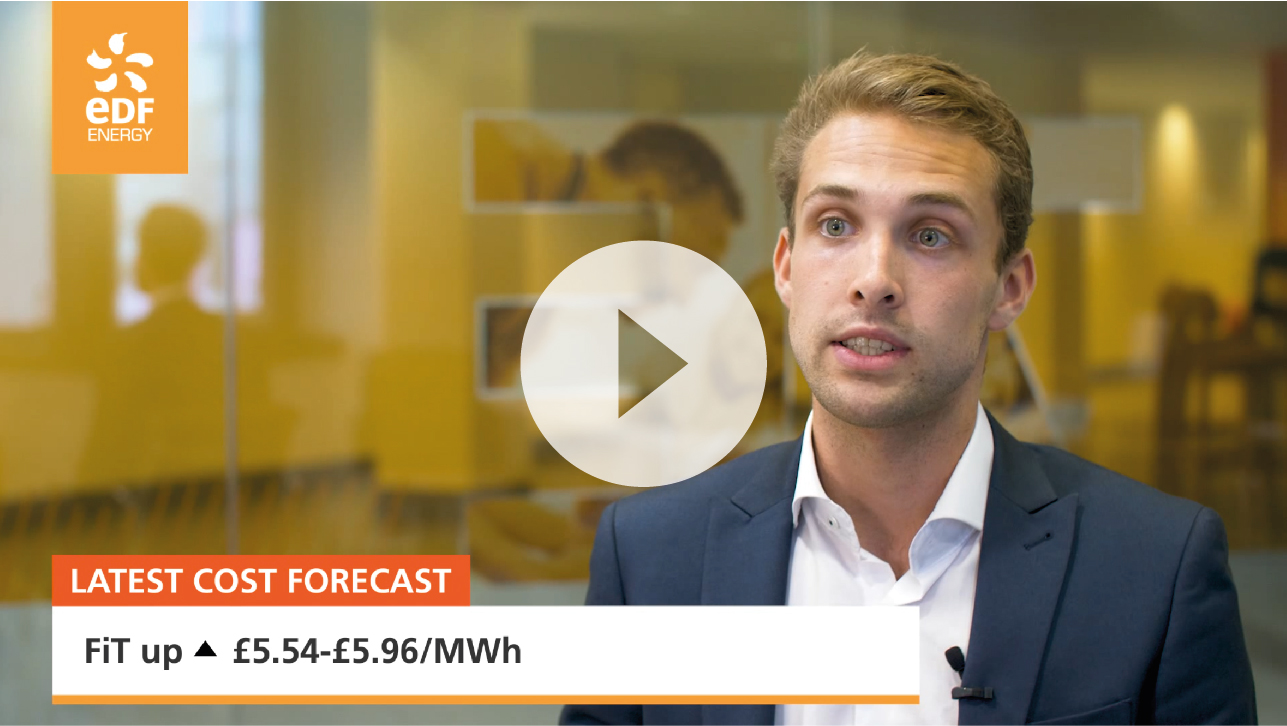
Certainty forecast - July 2017
You told us you wanted to receive your energy news in quick soundbites, straight to your desktop. So, that’s what we’re giving you.
I’m Simon Vicary, Senior Manager of Charging Development, focusing on non-energy costs here at EDF Energy and I’ll be bringing you up to speed on this month’s non-energy cost forecast.
Here are this month’s top stories… (if you have any questions about the impact on your business, feel free to pick up the phone to your relationship manager.)
James Chaplin, our analyst for FiT, RO and CfD costs, sums up the latest forecast:
 |
More capacity, more costs. FiT up ^
Feed in Tariff costs seem to be trending up as capacity increases.
What should you watch out for? Our team suggests you’ll need to watch out for potential sharp increases in costs for customers who continue to pay FiT.
Why is that? That seems to be due to an increased number of applications submitted before the Ofgem cap was implemented on 8th February 2016. This caps places limits on the total capacity that can receive a particular tariff rate in a particular tariff period and was brought in to control capacity entering the scheme, and therefore cost of the scheme. Based on information available on the Ofgem website it seems the resulting backlog of applications is now being cleared at a fast pace.(1)
Last-minute rush. RO up ^
Although officially closed to new applicants on 31st March 2017 (excluding some grace periods), the Renewable Obligation is expected to grow over the next few years with new capacity starting generating.
What should you watch out for? One of the most expensive of all the low-carbon schemes, RO is likely to hit a high of £18-19/MWh in 2017 and rise for the next few years. That’s the prediction of James Chaplin, our RO analyst, based on market forecasts.
Black Start. BSUoS up ^
Balancing costs appear to be trending up as the Black Start contracts bed in.
What should you watch out for? The significant costs associated with Black Start contracts will begin to feed into the BSUoS settlement data from June 2017 as this is when the relevant period starts. As a result, our team have increased their previous forecast.
Why is that? National Grid is required by law to have contracts with generators that can help the transmission system recover from a total or partial shutdown, commonly known as a Black Start. They spent £113m (2) on this last year and the cost will likely now be passed on to energy users.
What’s the longer-term trend? Look out for potentially more unpredictability to come in the costs that are required to balance the system, our team says. This is due to the continued increase in intermittent generation like wind and solar PV.
No more bids. CMSC up ^
Capacity Market Supplier Charge forecast seems to have firmed up, as this year’s Capacity Market auctions are now over.
What should you watch out for? Both the main and Transitional Arrangements auctions closed for 2017/18 on 3rd February 2017. That means the price and volume of the Capacity Market contracts is now known and has gone into the latest figures, thus increasing the CM forecast.
Why is that? In the recent Transitional Arrangements auction, only a limited amount of volume was procured at a high price of £45.00/Kw/Year (3) which could mean a slight overall increase in the cost for customers.
What might change? Our team can’t yet quantify is the chargeable volume over which these costs will be spread, so there is still some room for movement in the next 12 months.
Delays, delays. CfD down
Late running of projects and delays in EII legislation mean Contract for Difference costs appear to be trending down in the short term.
What should you watch out for? Several projects in the CfD scheme have had their expected start dates pushed back. Our CfD analyst, James Chaplin, predicts this could have a positive impact on energy bills over the next few years as less energy is generated through the scheme than previously forecasted.
What’s happening to EII? As announced by Department for Energy Security and Net Zero (DESNZ) , Energy Intensive Industry exemptions have also been pushed back because the legislation wasn’t completed on time. Originally slated for April this year, the Government have just announced that it will now take effect in January next year for RO and we expect April next year for CfD and FiT. (4)
Anything else to know? If you have customers who you think may qualify for EII exemptions, and you’d like to see how they can apply, take a look at our guide.

Looking ahead
Ofgem proposes a review of transmission and distribution network charges – Half Hourly meter customers should take note
What’s the proposal? Ofgem has proposed a review of the way that charges are levied for use of the transmission and distribution network, commonly known as TNUoS, BSUoS and DUoS. In the next few weeks, we are waiting to see whether Ofgem decide if they’re going ahead with the review and what it will be in scope.
What impact might it have on you? Although any proposed changes may not come into effect until the early 2020s, the impact may be significant for customers on Half Hourly meters. Over the coming months, you’ll have the opportunity to make your views known to Ofgem and other industry bodies.
Get the full story
That’s it for this month’s round-up. For our complete view of non-energy cost forecasts, read the latest edition of Monitor.
Till next time…
 Simon Vicary has 26 years of energy industry experience, most recently looking at network and system forecasts and ensuring that energy costs are fair and reasonable. |  James Chaplin is a market analyst in our wholesale markets team, responsible for low carbon costs including CfD, RO and FiT. |
(1) https://www.ofgem.gov.uk/environmental-programmes/fit/contacts-guidance-and-resources/public-reports-and-data-fit/feed-tariffs-deployment-caps-reports
(2) http://www2.nationalgrid.com/UK/Industry-information/System-charges/Electricity-transmission/News/Recovery-of-2016/17-Black-Start-Costs/
(3) https://www.emrdeliverybody.com/Capacity%20Markets%20Document%20Library/Transitional%20Auction%2017-18%20Provisional%20Results%20Report.pdf
(4) https://www.gov.uk/government/uploads/system/uploads/attachment_data/file/630242/EII_RO_exemption-Government_Response-FINALV2.pdf
Post a comment
Related articles

Registration window open for new Energy Broker Dispute Resolution Scheme


